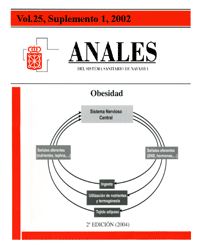Pharmacological treatment of obesity
DOI:
https://doi.org/10.23938/ASSN.0822Keywords:
Obesidad. Sibutramina. Orlistat. Agonistas b-3 adrenérgicos. GLP-1. Colecistoquinina.Abstract
The foundation on which the treatment of obesity rests is made up of the procedures aimed at unbalancing the equation of energy balance in favour of calorie consumption. Pharmacological treatment is aimed at favouring a reduction of calorie intake or stimulating calorie production. Depending on their mechanism of action, the drugs that are used in the treatment of obesity can be divided into appetite inhibitors, inhibitors of food intake or blockers of fat digestion and stimulators of thermogenesis. Amongst the appetite inhibitors, besides the adrenergic agents such as those of the amphetamine type, which are forbidden because of their addictive effect, are the serotonin uptake inhibitors such as dexfenfluramine (withdrawn in 1997) and fluoxetine. The recent commercialisation of sibutramine, a serotonin and norepinephrine reuptake inhibitor with an appetite inhibiting and thermogenesis stimulating effect, offer new perspectives in this field. Amongst inhibitors, mention is deserved by orlistat that inhibits the absorption of upto 30% of ingested fat without causing secondary effects of significance. In the area of thermogenic drugs there are the ephedrine-caffeine association, and the adrenergic beta antagonists, which are still being researched. There are numerous future perspectives amongst which are leptin, analogs of GLP-1 and cholecystokinin and neuropeptide Y antagonists. It is necessary to have reliable predictive elements that make it possible to know the most useful drugs, as well as the sort of patients who will benefit most from the different pharmacological treatments.Downloads
Downloads
Published
How to Cite
Issue
Section
License
La revista Anales del Sistema Sanitario de Navarra es publicada por el Departamento de Salud del Gobierno de Navarra (España), quien conserva los derechos patrimoniales (copyright ) sobre el artículo publicado y favorece y permite la difusión del mismo bajo licencia Creative Commons Reconocimiento-CompartirIgual 4.0 Internacional (CC BY-SA 4.0). Esta licencia permite copiar, usar, difundir, transmitir y exponer públicamente el artículo, siempre que siempre que se cite la autoría y la publicación inicial en Anales del Sistema Sanitario de Navarra, y se distinga la existencia de esta licencia de uso.








